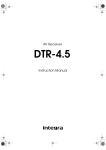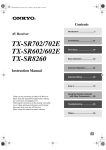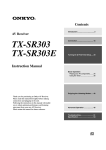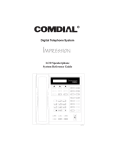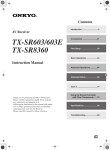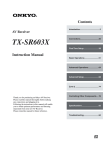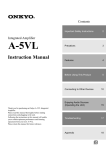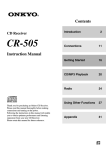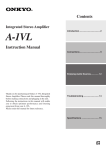Download Onkyo TX-8011 Receiver
Transcript
TX-8011_E.book Page 1 Friday, July 30, 2004 10:33 AM Contents Introduction ..................................... 2 Stereo Receiver TX-8011 Connection .................................... 11 Playing Your Components ........... 17 Using the Tuner ............................. 19 Instruction Manual Recording ...................................... 21 Thank you for purchasing an Onkyo Stereo Receiver. Please read this manual thoroughly before making connections and plugging in the unit. Following the instructions in this manual will enable you to obtain optimum performance and listening enjoyment from your new Stereo Receiver. Please retain this manual for future reference. Troubleshooting ............................ 22 Specifications................................ 23 En TX-8011_E.book Page 2 Friday, July 30, 2004 10:33 AM WARNING: TO REDUCE THE RISK OF FIRE OR ELECTRIC SHOCK, DO NOT EXPOSE THIS APPLIANCE TO RAIN OR MOISTURE. CAUTION: TO REDUCE THE RISK OF ELECTRIC SHOCK, DO NOT REMOVE COVER (OR BACK). NO USER-SERVICEABLE PARTS INSIDE. REFER SERVICING TO QUALIFIED SERVICE PERSONNEL. WARNING AVIS RISK OF ELECTRIC SHOCK DO NOT OPEN RISQUE DE CHOC ELECTRIQUE NE PAS OUVRIR The lightning flash with arrowhead symbol, within an equilateral triangle, is intended to alert the user to the presence of uninsulated “dangerous voltage” within the product’s enclosure that may be of sufficient magnitude to constitute a risk of electric shock to persons. The exclamation point within an equilateral triangle is intended to alert the user to the presence of important operating and maintenance (servicing) instructions in the literature accompanying the appliance. Important Safeguards 1. Read Instructions—All the safety and operating instructions should be read before the appliance is operated. 2. Retain Instructions—The safety and operating instructions should be retained for future reference. 3. Heed Warnings—All warnings on the appliance and in the operating instructions should be adhered to. 4. Follow Instructions—All operating and use instructions should be followed. 5. Cleaning—Unplug the appliance from the wall outlet before cleaning. The appliance should be cleaned only as recommended by the manufacturer. 6. Attachments—Do not use attachments not recommended by the appliance manufacturer as they may cause hazards. 7. Water and Moisture—Do not use the appliance near water –for example, near a bath tub, wash bowl, kitchen sink, or laundry tub; in a wet basement; or near a swimming pool; and the like. 8. Accessories—Do not place PORTABLE CART WARNING the appliance on an unstable cart, stand, tripod, bracket, or table. The appliance may fall, causing serious injury to a child or adult, and seriS3125A ous damage to the appliance. Use only with a cart, stand, tripod, bracket, or table recommended by the manufacturer, or sold with the appliance. Any mounting of the appliance should follow the manufacturer’s instructions, and should use a mounting accessory recommended by the manufacturer. 9. An appliance and cart combination should be moved with care. Quick stops, excessive force, and uneven surfaces may cause the appliance and cart combination to overturn. 10. Ventilation—Slots and openings in the cabinet are provided for ventilation and to ensure reliable operation of the appliance and to protect it from overheating, and these openings must not be blocked or covered. The openings should never be blocked by placing the appliance on a bed, sofa, rug, or other similar surface. The appliance should not be placed in a built-in installation such as a bookcase or rack unless proper ventilation is provided. There should be free space of at least 8 in. (20 cm) and an opening behind the appliance. 2 11. Power Sources—The appliance should be operated only from the type of power source indicated on the marking label. If you are not sure of the type of power supply to your home, consult your appliance dealer or local power company. 12. Grounding or Polarization—The appliance may be equipped with a polarized alternating current line plug (a plug having one blade wider than the other). This plug will fit into the power outlet only one way. This is a safety feature. If you are unable to insert the plug fully into the outlet, try reversing the plug. If the plug should still fail to fit, contact your electrician to replace your obsolete outlet. Do not defeat the safety purpose of the polarized plug. 13. Power Cord Protection—Power-supply cords should be routed so that they are not likely to be walked on or pinched by items placed upon or against them, paying particular attention to cords at plugs, convenience receptacles, and the point where they exit from the appliance. 14. Outdoor Antenna Grounding—If an outside antenna or cable system is connected to the appliance, be sure the antenna or cable system is grounded so as to provide some protection against voltage surges and built-up static charges. Article 810 of the National Electrical Code, ANSI/NFPA 70, provides information with regard to proper grounding of the mast and supporting structure, grounding of the leadin wire to an antenna-discharge unit, size of grounding conductors, location of antenna-discharge unit, connection to grounding electrodes, and requirements for the grounding electrode. See Figure 1. 15. Lightning—For added protection for the appliance during a lightning storm, or when it is left unattended and unused for long periods of time, unplug it from the wall outlet and disconnect the antenna or cable system. This will prevent damage to the appliance due to lightning and power-line surges. 16. Power Lines—An outside antenna system should not be located in the vicinity of overhead power lines or other electric light or power circuits, or where it can fall into such power lines or circuits. When installing an outside antenna system, extreme care should be taken to keep from touching such power lines or circuits as contact with them might be fatal. TX-8011_E.book Page 3 Friday, July 30, 2004 10:33 AM Important Safeguards—Continued 17. Overloading—Do not overload wall outlets, extension cords, or integral convenience receptacles as this can result in a risk of fire or electric shock. 18. Object and Liquid Entry—Never push objects of any kind into the appliance through openings as they may touch dangerous voltage points or short-out parts that could result in a fire or electric shock. Never spill liquid of any kind on the appliance. 19. Servicing—Do not attempt to service the appliance yourself as opening or removing covers may expose you to dangerous voltage or other hazards. Refer all servicing to qualified service personnel. 20. Damage Requiring Service—Unplug the appliance from the wall outlet and refer servicing to qualified service personnel under the following conditions: A. When the power-supply cord or plug is damaged, B. If liquid has been spilled, or objects have fallen into the appliance, C. If the appliance has been exposed to rain or water, D. If the appliance does not operate normally by following the operating instructions. Adjust only those controls that are covered by the operating instructions as an improper adjustment of other controls may result in damage and will often require extensive work by a qualified technician to restore the appliance to its normal operation, E. If the appliance has been dropped or damaged in any way, and F. When the appliance exhibits a distinct change in performance – this indicates a need for service. 21. Replacement Parts—When replacement parts are required, be sure the service technician has used replacement parts specified by the manufacturer or have the same characteristics as the original part. Unauthorized substitutions may result in fire, electric shock, or other hazards. 22. Safety Check—Upon completion of any service or repairs to the appliance, ask the service technician to perform safety checks to determine that the appliance is in proper operation condition. 23. Wall or Ceiling Mounting—The appliance should be mounted to a wall or ceiling only as recommended by the manufacturer. 24. Heat—The appliance should be situated away from heat sources such as radiators, heat registers, stoves, or other appliances (including amplifiers) that produce heat. 25. Liquid Hazards—The appliance should not be exposed to dripping or splashing and no objects filled with liquids, such as vases should be placed on the appliance. FIGURE 1: EXAMPLE OF ANTENNA GROUNDING AS PER NATIONAL ELECTRICAL CODE, ANSI/NFPA 70 ANTENNA LEAD IN WIRE GROUND CLAMP ANTENNA DISCHARGE UNIT (NEC SECTION 810-20) ELECTRIC SERVICE EQUIPMENT GROUNDING CONDUCTORS (NEC SECTION 810-21) GROUND CLAMPS NEC – NATIONAL ELECTRICAL CODE S2898A POWER SERVICE GROUNDING ELECTRODE SYSTEM (NEC ART 250, PART H) 3 TX-8011_E.book Page 4 Friday, July 30, 2004 10:33 AM Precautions 1. Recording Copyright—Unless it’s for personal use only, recording copyrighted material is illegal without the permission of the copyright holder. 2. AC Fuse—The AC fuse inside the TX-8011 Receiver is not user-serviceable. If you cannot turn on the TX-8011 Receiver, contact your Onkyo dealer. 3. Care—Occasionally you should dust the TX-8011 Receiver all over with a soft cloth. For stubborn stains, use a soft cloth dampened with a weak solution of mild detergent and water. Dry the TX-8011 Receiver immediately afterwards with a clean cloth. Don’t use abrasive cloths, thinners, alcohol, or other chemical solvents, because they may damage the finish or remove the panel lettering. 4. Power WARNING BEFORE PLUGGING IN THE UNIT FOR THE FIRST TIME, READ THE FOLLOWING SECTION CAREFULLY. AC outlet voltages vary from country to country. Make sure that the voltage in your area meets the voltage requirements printed on the TX-8011 Receiver’s rear panel (e.g., AC 230 V, 50 Hz or AC 120 V, 60 Hz). Setting the [STANDBY/ON] switch to STANDBY does not fully shutdown the TX-8011 Receiver. If you do not intend to use the TX-8011 Receiver for an extended period, remove the power cord from the AC outlet. Memory backup The TX-8011 uses a battery-less memory backup system in order to retain radio presets and other settings when it’s unplugged or in the case of a power failure. Although no batteries are required, the TX-8011 Receiver must be plugged into an AC outlet in order to charge the backup system. Once it has been charged, the TX-8011 Receiver will retain the settings for several weeks, although this depends on the environment and will be shorter in humid climates. For U.S. models Note to CATV system installer: This reminder is provided to call the CATV system installer's attention to Section 820-40 of the NEC which provides guideline for proper grounding and, in particular, specified that the cable ground shall be connected to the grounding system of the building, as close to the point of cable entry as practical. FCC Information for User CAUTION: The user changes or modifications not expressly approved by the party responsible for compliance could void the user’s authority to operate the equipment. NOTE: This equipment has been tested and found to comply with the limits for a Class B digital device, pursuant to Part 15 of the FCC Rules. These limits are designed to provide reasonable protection against harmful interference in a residential installation. This equipment generates, uses and can radiate radio frequency energy and, if not installed and used in accordance with the instructions, may cause harmful interference to radio communications. However, there is no guarantee that interference will not occur in a particular installation. If this equipment does cause harmful interference to radio or television reception, which can be determined by turning the equipment off and on, the user is encouraged to try to correct the interference by one or more of the following measures: • Reorient or relocate the receiving antenna. • Increase the separation between the equipment and receiver. • Connect the equipment into an outlet on a circuit different from that to which the receiver is connected. • Consult the dealer or an experienced radio/TV technician for help. For Canadian models For models having a power cord with a polarized plug: CAUTION: TO PREVENT ELECTRIC SHOCK, MATCH WIDE BLADE OF PLUG TO WIDE SLOT, FULLY INSERT. Modèle pour les Canadien Sur les modèles dont la fiche est polarisee: ATTENTION: POUR ÉVITER LES CHOCS ÉLECTRIQUES, INTRODUIRE LA LAME LA PLUS LARGE DE LA FICHE DANS LA BORNE CORRESPONDANTE DE LA PRISE ET POUSSER JUSQU’AU FOND. 4 TX-8011_E.book Page 5 Friday, July 30, 2004 10:33 AM Features Contents • 50 W/ch min. RMS at 8 ohms, both channels driven from 20 Hz to 20 kHz, with no more than 0.08% THD. • Discrete output stage circuits for true high-current, low-impedance drive. • Expensive, high-quality parts, such as high-power transistors, an oversized power transformer, and heavy duty extruded heatsink, make it possible to accurately and effortlessly drive 4-ohm speakers. • 4 audio inputs • A/B speaker selectors and outputs • Cassette tape dubbing capability • 30 FM/AM radio presets • Preset scan tuning • 3 radio preset groups (10 presets per group) • Direct access tuning • Motorized, precision volume control • Headphone jack • Audio mute, sleep timer (via remote) • Battery-free memory backup • compatible remote control Important Safeguards........................................ 2 Supplied Accessories Make sure you have the following accessories: Remote controller (RC-330S) & two batteries (AA/R6) Indoor FM antenna AM loop antenna * In catalogs and on packaging, the letter added to the end of the product name indicates the color of the TX-8011. Specifications and operation are the same regardless of color. Precautions ........................................................ 4 Features.............................................................. 5 Supplied Accessories ....................................... 5 Contents ............................................................. 5 Front & Rear Panels .......................................... 6 Front Panel........................................................ 6 Display............................................................... 7 Rear Panel ........................................................ 8 Remote Controller ............................................. 9 Installing the Batteries ..................................... 10 Using the Remote Controller ........................... 10 Connections ..................................................... 11 Connecting Speakers ...................................... 11 Connecting the Supplied FM & AM Indoor Antennas ......................................................... 12 Connecting an Outdoor FM Antenna............... 13 Connecting an Outdoor AM Antenna .............. 13 Connecting a CD Player.................................. 14 Connecting a Cassette Recorder .................... 14 Connecting a Turntable ................................... 14 Connecting Components ......................... 15 Connecting the Power Cord of Another Component...................................................... 15 Connecting the Power Cord ............................ 16 Turning On the TX-8011.................................. 16 Playing Your Components.............................. 17 Selecting the Source Component.................... 17 Using a Graphic Equalizer............................... 17 Adjusting the Bass, Treble & Balance ............. 17 Muting the TX-8011......................................... 17 Using the Sleep Timer..................................... 18 Using Headphones.......................................... 18 Using the Tuner ............................................... 19 Listening to the Radio...................................... 19 Tuning into Radio Stations .............................. 19 Presetting Radio Stations................................ 20 Selecting Presets ............................................ 20 Deleting Presets .............................................. 20 Recording ......................................................... 21 Recording the Input Source............................. 21 Tape-to-tape Dubbing ..................................... 21 Monitoring While Recording ............................ 21 Troubleshooting .............................................. 22 Power .............................................................. 22 Audio ............................................................... 22 Tuner ............................................................... 22 Remote Controller ........................................... 22 Specifications .................................................. 23 5 TX-8011_E.book Page 6 Friday, July 30, 2004 10:33 AM Front & Rear Panels Front Panel 2 34 1 M N 5 6 O For detailed information, refer to the pages in parentheses. A STANDBY/ON button (16) This button is used to set the TX-8011 to On or Standby. B STANDBY indicator (16) This indicator lights up when the TX-8011 is in Standby mode, and it flashes while a signal is being received from the remote controller. C Remote control sensor (10) This sensor receives control signals from the remote controller. D TUNING [ ]/[ ] buttons (19) These buttons are used to tune into radio stations. E DIRECT TUNING button (19) This button is used to select a station by entering the frequency. F Display See “Display” on page 7 for more information. G MEMORY button (20) This button is used to preset radio stations. H FM MODE button (20) This button is used to select the FM radio Auto and Mono modes. I GROUP button (20) This button is used to select the radio preset groups. J Number buttons (20) These buttons are used to select preset radio stations, and to select stations by frequency. K SCAN button (20) This button is used to scan preset radio stations. 6 789 P J K L Q R S L VOLUME control (17) M N O P Q R S This control is used to set the volume of the TX-8011. PHONES jack (18) This 1/4-inch phone jack is for connecting a standard pair of stereo headphones. SPEAKERS A & B buttons (17) These buttons are used to turn speaker sets A and B on and off. TAPE 2 MONITOR button (17, 21) This button is used to select the component connected to the TAPE 2 IN jacks, or a graphic equalizer connected to the TAPE 2 IN/OUT jacks. Regardless of which input source is selected, the component connected to the TAPE 2 IN jacks will be heard when TAPE 2 indicator lights up. Input selector buttons (17, 21) These buttons are used to select the input sources. BASS control (17) This control is used to adjust the level of bass sounds. TREBLE control (17) This control is used to adjust the level of treble sounds. BALANCE control (17) This control is used to adjust the left and right balance. TX-8011_E.book Page 7 Friday, July 30, 2004 10:33 AM Front & Rear Panels—Continued Display 1 23 STEREO MODE 4 5 SPEAKERS A B T-2 MONITOR AUDIO MUTE 6 78 FM MUTE ON OFF TUNED STEREO MEMORY 9J GROUP A B C SLEEP AUTO kHz MHz MONO CH MIN K A STEREO MODE AUTO/FM MUTE ON B C D E F indicators (19) These indicators light up when the tuner is tuned to an FM station and Stereo mode is selected. STEREO MODE MONO/FM MUTE OFF indicators (19) These indicators light up when the tuner is tuned to an FM station and Mono mode is selected. T-2 MONITOR indicator (17, 19) This indicator lights up when TAPE 2 is selected. Regardless of which input source is selected, the component connected to the TAPE 2 IN jacks will be heard when this indicator lights up. SPEAKERS A B indicators (17) These indicators show which speakers are on or off. AUDIO MUTE indicator (17) This indicator flashes when the TX-8011 is muted. TUNED indicator (19) This indicator lights up when the TX-8011 is tuned into a radio station. G STEREO indicator (19) H I J K This indicator lights up when the tuner is tuned to a stereo FM station. MEMORY indicator (20) This indicator lights up when presetting radio stations. GROUP A B C indicators These indicators show which radio preset group is selected. SLEEP indicator (18) This indicator lights up when the Sleep function has been set. Message area This area of the display shows various information about the currently selected source. 7 TX-8011_E.book Page 8 Friday, July 30, 2004 10:33 AM Front & Rear Panels—Continued Rear Panel 1 3 2 5 4 6 AM REMOTE CONTROL ANTENNA GND FM 75 SPEAKERS R IN IN OUT IN OUT L L AC OUTLET IN A A B B R R PHONO CD 78 TAPE 1 TAPE 2 C D E F 8 J 9 A Grounding screw (14) B AC 120V 60Hz SWITCHED 120W 1A MAX. L This screw is for connecting a turntable’s ground wire. AM ANTENNA (12, 13) These push terminals are for connecting an AM antenna. FM ANTENNA (12, 13) This socket is for connecting an FM antenna. SPEAKERS A (11) These lever terminals are for connecting speaker set A. SPEAKERS B (11) These lever terminals are for connecting speaker set B. (15) These (Remote Interactive) jacks can be connected to the jacks on other Onkyo CD player and cassette recorder. The TX-8011’s remote controller can then be used to control those components. Note: To use , you must make an analog audio connection between the TX-8011 and the other component. can only be used with Onkyo components. G PHONO IN (14) These jacks can be used to connect a turntable with a moving-magnet cartridge. H CD IN (14) These jacks can be used to connect a CD player with an analog output. I TAPE 1, 2 IN/OUT (14) This analog audio input and output can be used to connect a cassette recorder, CD recorder, or other recorder with an analog input and output. Alternatively, they could be used to connect a graphic equalizer. J AC OUTLET (15) This switched AC outlet can be used to supply power to another component. TX-8011_E.book Page 9 Friday, July 30, 2004 10:33 AM Remote Controller 1 TAPE-1 2 SLEEP POWER INPUT SELECTOR TUNER PHONO 6 CD TAPE-2 DECK-A DECK-B 3 4 GROUP TUNER PRESET MUTING 7 CD 5 DISC VOLUME 8 REMOTE CONTROLLER RC-330S A POWER button (16) E CD (works only with Onkyo CD players This button is used to set the TX-8011 to On or standby. B INPUT SELECTOR buttons (17, 19) These buttons are used to select the input sources. C DECK-A & DECK-B (works only with Onkyo cassette recorder connected via . For singlecassette recorder, use the DECK-B buttons) Play [ ] button This button is used to start tape playback. Reverse Play [ ] button This button is used to start reverse playback. Rec/Pause [ ]/[ ] button This button is used to start and pause tape recording. Stop [ ] button This button is used to stop tape playback. Rewind/FF [ ]/[ ] buttons The Rewind [ ] button is used to start rewind. The FF [ ] button is used to start fast forward. D TUNER (19, 20) GROUP button This button is used to select the radio preset groups. PRESET [ ]/[ ] buttons These buttons are used to select the radio presets. connected via ) Pause [ ] button This button is used to pause CD playback. Stop [ ] button This button is used to stop CD playback. Play [ ] button This button is used to start CD playback. DISC button This button is used to select discs on a CD changer. Previous & Next [ ]/[ ] buttons The Previous [ ] button is used to select the previous track. During playback, the first press selects the beginning of the current track. The Next [ ] button is used to select the next track. F SLEEP button (18) This button is used to set the Sleep function. G MUTING button (17) This button is used to mute the TX-8011. H VOLUME [ ]/[ ] buttons (17) These buttons are used to set the volume of the TX-8011. 9 TX-8011_E.book Page 10 Friday, July 30, 2004 10:33 AM Remote Controller—Continued Installing the Batteries 1 Open the battery compartment, as shown. Using the Remote Controller To use the remote controller, point it at the TX-8011’s remote control sensor, as shown below. Remote control sensor 2 3 Insert the two supplied batteries (AA/R6) in accordance with the polarity diagram inside the battery compartment. Close the battery compartment. Notes: • The batteries should last for about six months, although this will vary with usage. • If the remote controller doesn’t work reliably, try replacing the batteries. • Don’t mix new and old batteries or different types of batteries. • If you intend not to use the remote controller for a long time, remove the batteries to prevent damage from leakage or corrosion. • Expired batteries should be removed as soon as possible to prevent damage from leakage or corrosion. 10 30˚ 30˚ 6f .1 rox m) p Ap (5 t. Notes: • The remote controller may not work reliably if the TX-8011 is subjected to bright light, such as direct sunlight or inverter-type fluorescent lights. Keep this in mind when installing. • If another remote controller of the same type is used in the same room, or the TX-8011 is installed close to equipment that uses infrared rays, the remote controller may not work reliably. • Don’t put anything, such as a book, on the remote controller, because the buttons may be pressed inadvertently, thereby draining the batteries. • The remote controller may not work reliably if the TX-8011 is installed in a rack behind colored glass doors. Keep this in mind when installing. • The remote controller will not work if there’s an obstacle between it and the TX-8011’s remote control sensor. TX-8011_E.book Page 11 Friday, July 30, 2004 10:33 AM Connections • If you want to connect a single speaker instead of a pair, connect it to either the left or right speaker terminals, not both. Connecting Speakers Before you connect your speakers, read the following: • Disconnect the power cord from the wall outlet. • Read the instructions supplied with your speakers. • Pay close attention to speaker wiring polarity. In other words, connect positive (+) terminals only to positive (+) terminals, and negative (–) terminals only to negative (–) terminals. If you get them the wrong way around, the sound will be out of phase and will sound odd. • The impedance of each speaker connected to this unit must be no lower than 4 ohms. If you’re using only speakers A or speakers B, the minimum speaker impedance is 4 ohms. If you’re using both speakers A and speaker B, the minimum speaker impedance is 8 ohms. If you use speakers with a lower impedance, and use the amplifier at high volume levels for a long period of time, the built-in protection circuit may be activated. • Unnecessarily long or very thin speaker cables may affect the sound quality and should be avoided. • Be careful not to short the positive NO! and negative connections. Doing so may damage the TX-8011. • Don’t connect more than one cable to each speaker terminal. Doing so may damage the TX-8011. NO! R L A A NO! R L A A 1 Strip 3/8" (10 mm) of insulation from the ends of the speaker cables, and twist the bare wires tightly. 2 Push the lever to open the hole, insert the bare wire into the hole, and then push the lever again to close the hole, thereby securing the wire. A B 3/8" (10 mm) Maker sure that the speaker connectors are gripping the bare wires, not the insulation. The following illustration shows which speakers should be connected to which terminals. Speaker set A Right speaker Left speaker SPEAKERS R L AM REMOTE CONTROL A A B B ANTENNA GND FM 75 SPEAKERS R IN IN OUT IN OUT AC OUTLET IN L L R R PHONO CD TAPE 1 L A A B B AC 120V 60Hz SWITCHED 120W 1A MAX. TAPE 2 CAUTION: SPEAKER IMPEDANCE A or B: 4 ohms min./speaker A + B: 8 ohms min./speaker Right speaker Left speaker Speaker set B 11 TX-8011_E.book Page 12 Friday, July 30, 2004 10:33 AM Connections—Continued Connecting the Supplied FM & AM Indoor Antennas ANTENNA AM REMOTE CONTROL ANTENNA GND FM 75 SPEAKERS R IN IN OUT IN OUT L L AC OUTLET IN A A B B L R AC 120V 60Hz SWITCHED 120W 1A MAX. R PHONO CD TAPE 1 TAPE 2 Adjusting the Position of the FM Indoor Antenna The FM indoor antenna is for indoor use only. Extend the antenna fully and point it in various directions to find the best reception. Secure it in that position with thumbtacks or something similar. If the reception is not very good with the supplied FM indoor antenna, use an outdoor antenna. 1 Strip the insulation from the end of the wire. AM 2 Fully insert the bare wire. ANTENNA GND FM 75 Adjusting the Position of the AM Indoor Antenna The AM loop antenna is for indoor use only. Position it to obtain the best radio reception. Put it as far away as possible from the TX-8011, your TV, speaker cables, and power cords. If the reception is not very good with the supplied AM loop antenna alone, use an outdoor AM antenna as well. Note: Connect both wires of the AM loop antenna to the AM push terminals, as shown. (The antenna’s wires are not polarity sensitive, so they can be connected either way around). Rotate the outer frame of the antenna. Insert the tab into the hole. Extend the antenna cord. AM indoor antenna Push the lever. Insert the wire into the hole. Release the lever to secure the wire. AM ANTENNA GND FM 75 12 TX-8011_E.book Page 13 Friday, July 30, 2004 10:33 AM Connections—Continued Connecting an Outdoor FM Antenna Connecting an Outdoor AM Antenna If you cannot achieve good reception with the supplied indoor FM antenna, try a commercially available outdoor FM antenna instead. If good reception cannot be achieved using the supplied AM loop antenna, an outdoor AM antenna can be used in addition to the loop antenna, as shown. Outdoor antenna FM 75 Insulated antenna cable AM loop antenna Notes: • Outdoor FM antennas work best outside, but usable results can sometimes be obtained when installed in an attic or loft. • For best results, install the outdoor FM antenna well away from tall buildings, preferably with a clear line of sight to your local FM transmitter. • Outdoor antenna should be located away from possible noise sources, such as neon signs, busy roads, etc. • For safety reasons, outdoor antenna should be situated well away from power lines and other high-voltage equipment. • Outdoor antenna must be grounded in accordance with local regulations to prevent electrical shock hazards. AM Outdoor AM antennas work best when installed outside horizontally, but good results can sometimes be obtained indoors by mounting the antenna horizontally above a window. Note that the AM loop antenna should be left connected. Outdoor antenna must be grounded in accordance with local regulations to prevent electrical shock hazards. Using a TV/FM Antenna Splitter It’s best not to use the same antenna for both FM and TV reception, as this can cause interference problems. If circumstances demand it, use a TV/FM antenna splitter, as shown. TV/FM antenna splitter To TX-8011 To TV (or VCR) 13 TX-8011_E.book Page 14 Friday, July 30, 2004 10:33 AM Connections—Continued TAPE 2 Connecting a CD Player Use an RCA audio cable to connect the TX-8011’s CD IN L/R jacks to the analog audio output jacks on your CD player, as shown. AM IN ANTENNA GND FM 75 SPEAKE R IN OUT IN IN OUT IN A L L R R B PHONO CD TAPE 1 Use an RCA audio cable to connect the TX-8011’s TAPE 2 IN L/R jacks to the cassette recorder’s output jacks, and use another analog audio cable to connect the TX-8011’s TAPE 2 OUT L/R jacks to the cassette recorder’s input jacks, as shown. Connecting your 3-head tape recorder to the TAPE 2 IN/OUT jacks, and pressing the [TAPE 2 MONITOR] button allows real-time monitoring while recording. Tip: • Alternatively, you could connect a graphic equalizer to the TAPE 2 IN/OUT jacks. TAPE 2 Connecting a Turntable OUT CD player Connecting a Cassette Recorder TAPE 1 Use an RCA audio cable to connect the TX-8011’s TAPE 1 IN L/R jacks to the cassette recorder’s output jacks, and use another audio cable to connect the TX-8011’s TAPE 1 OUT L/R jacks to the cassette recorder’s input jacks, as shown. Tip: • You can connect other types of recorders (CD recorder, etc) to the TAPE 2 IN/OUT jacks. The TX-8011’s PHONO IN L/R jacks are for use with moving magnet (MM) type cartridges. Use an RCA audio cable to connect the TX-8011’s PHONO IN L/R jacks to the audio output jacks on your turntable, as shown. Notes: • If your turntable has a ground wire, connect it to the GND screw on the TX-8011. With some turntables, connecting the ground wire may cause hum, in which case it should be disconnected. • If your turntable has a moving coil (MC) type cartridge, you’ll need a commercially available MC head amp. Connect your turntable to the head amp, and connect the head amp to the TX-8011’s PHONO IN L/ R jacks. • You can also use a phono equalizer to connect a turntable with an MC-type cartridge. In this case, see the phono equalizer’s manual for details. AM OUT IN IN ANTENNA AM L GND FM 75 SPEAKERS R ANTENNA L GND IN OUT IN IN OUT L IN A A B B R FM 75 SPEAKERS L R R TAPE 1 R IN IN OUT IN OUT L PHONO CD TAPE 1 PHONO IN L B TAPE 2 R R PHONO CD TAPE 1 TAPE 2 GND REC (IN) Cassette recorder L PLAY (OUT) L AUDIO OUTPUT L / R R R 14 A L TX-8011_E.book Page 15 Friday, July 30, 2004 10:33 AM Connections—Continued Connecting Components With (Remote Interactive) you can control your -compatible Onkyo CD player and cassette recorder with the TX-8011’s remote controller, and use the following special functions: Direct Change When playback is started on a component connected via , the TX-8011 automatically selects that component as the input source. Connecting the Power Cord of Another Component The TX-8011 has a switched AC outlet on its rear panel that can be used to connect the power cord of another component that you intend to use with the TX-8011. These components can then be left turned on so that they turn on and off as and when the TX-8011 is turned on and set to Standby. AM IN REMOTE CONTROL ANTENNA GND FM 75 IN OUT IN OUT L AC 120V 60Hz SWITCHED 120W 1A MAX. L AC OUTLET IN A A B B AC 120V 60Hz SWITCHED 120W 1A MAX. L R AC OUTLET REMOTE CONTROL SPEAKERS R IN R PHONO CD TAPE 1 AC OUTLET TAPE 2 AC 120V 60Hz SWITCHED 120W 1A MAX. TAPE 1 IN REMOTE CONTROL CD AUDIO OUTPUT e.g., CD player L R AUDIO OUTPUT Caution: • Make sure that the capacity of the component that you connect to the AC OUTLET does not exceed the stated capacity (120 W). e.g., cassette recorder L / R Notes: • Push plugs in all the way to make good connections. • Use only cables for connections. An cable is not included with the TX-8011. • Some components have two jacks, you can connect either one to the TX-8011. The other is for connecting additional -compatible components. • Connect the TX-8011’s jacks to only Onkyo components. Connecting to other manufacturer’s components may cause them to malfunction. • Some components may not support all functions. Refer to the manuals supplied with your components. • To use , you must make an analog audio connection between the TX-8011 and the other component. 15 TX-8011_E.book Page 16 Friday, July 30, 2004 10:33 AM Connections—Continued Connecting the Power Cord Notes: • Before connecting the power cord, connect all of your speakers and components. • Turning on the TX-8011 may cause a momentary power surge that might interfere with other electrical equipment on the same circuit. If this is a problem, plug the TX-8011 into a different branch circuit. Turning On the TX-8011 STANDBY/ON POWER SLEEP POWER TAPE-1 INPUT SELECTOR TUNER PHONO CD TAPE-2 DECK-A GROUP TUNER PRESET DECK-B MUTING CD DISC VOLUME REMOTE CONTROLLER RC-330S Remote controller POWER 16 Press the [STANDBY/ON] button. Alternatively, press the remote controller’s [POWER] button. The TX-8011 comes on, the display lights up, and the STANDBY indicator goes off. To turn off the TX-8011, press the [STANDBY/ON] button, or the remote controller’s [POWER] button. The TX-8011 will enter Standby mode. To prevent any loud surprises the next time you turn on the TX-8011, always turn down the volume before you turn it off. TX-8011_E.book Page 17 Friday, July 30, 2004 10:33 AM Playing Your Components This chapter explains how to use the TX-8011 with your other components. TUNING SPEAKERS A/B VOLUME Input selector Using a Graphic Equalizer You can use a graphic equalizer by connecting it to the TAPE 2 IN/OUT jacks and selecting TAPE 2. 1 Press the [TAPE 2 MONITOR] button to select TAPE 2. The T-2 MONITOR indicator lights up. 2 Start playback on the selected component. See the graphic equalizer’s manual for details. BASS TREBLE TAPE 2 MONITOR BALANCE Adjusting the Bass, Treble & Balance Selecting the Source Component 1 You can adjust the bass, treble, and balance. Press an input selector button to select the component that you want to play. The name of the selected source appears on the display, as shown. Bass You can boost or cut low-frequency sounds output by the speakers. Turn clockwise to boost; counterclockwise to cut. Treble You can boost or cut high-frequency sounds output by the speakers. Turn clockwise to boost; counterclockwise to cut. A & B speakers indicators SPEAKERS A B Balance Selected input source 2 Use the SPEAKERS [A] or [B] button to select the speaker set that you want to use. The SPEAKERS A and B indicators show which speakers are on or off. Note: If both speaker indicators are off, no sound will come from speakers. 3 Start playback on the selected component. 4 To adjust the volume, use the VOLUME control, or the remote controller’s VOLUME buttons. You can adjust the left and right balance of the speakers and headphones. Turn clockwise to increase the output from the right channel; counterclockwise to increase the output from the left channel. Muting the TX-8011 You can temporarily mute the TX-8011. 1 MUTING Press the remote controller’s [MUTING] button. The output is muted and the AUDIO MUTE indicator flashes on the display, as shown. AUDIO MUTE To unmute the TX-8011, press the remote controller’s [MUTING] button again. The output is unmuted and the AUDIO MUTE indicator goes off. Muting is cancelled when the TX-8011 is set to Standby. 17 TX-8011_E.book Page 18 Friday, July 30, 2004 10:33 AM Playing Your Components—Continued Using the Sleep Timer With the sleep timer, you can set the TX-8011 so that it automatically turns off after a specified period. 1 SLEEP Press the remote controller’s [SLEEP] button repeatedly to select the required sleep time. You can set the sleep time from 90 to 10 minutes in 10-minute steps. The SLEEP indicator appears on the display when the sleep timer has been set, as shown. The specified sleep time appears on the display for about five seconds, then the previous display reappears. SLEEP indicator SLEEP MIN To cancel the sleep timer, press the remote controller’s [SLEEP] button repeatedly until the SLEEP indicator disappears. To check the remaining sleep time, press the remote controller’s [SLEEP] button. Note that if you press the [SLEEP] button while the sleep time is being displayed, you’ll shorten the sleep time by 10 minutes. Using Headphones You can connect a pair of stereo headphones (1/4-inch phone plug) to the TX-8011’s PHONES jack as shown. Notes: • Always turn down the volume before connecting your headphones. • The speakers are not automatically muted when the headphones are connected, but they can be turned off with the SPEAKERS A and B buttons. 18 TX-8011_E.book Page 19 Friday, July 30, 2004 10:33 AM Using the Tuner With the built-in tuner, you can enjoy AM and FM radio stations, and you can store your favorite stations as presets for quick selection. TUNING Manual Tuning Mode 1 Number MEMORY VOLUME Press the TUNING Up or Down [ ]/[ ] button. Press the buttons repeatedly to change the frequency one step at a time. The FM frequency changes in 0.1 MHz steps; 10 kHz steps for AM. Direct Tuning Mode DIRECT TUNING Press the [DIRECT TUNING] button. “_ _ ” will flash for 16 seconds on the display. 2 While the underscore characters are flashing, use the number buttons to enter the frequency. For example, to enter 88.1 MHz, press [8], [8], [1]. GROUP FM/AM SCAN Listening to the Radio 1 1 Press the [FM] or [AM] button. or Press the remote controller’s INPUT SELECTOR [TUNER] button (This will select the last station selected. You cannot switch between AM and FM with the remote controller.) In this example, FM has been selected. FM MUTE ON MHz Band CH Frequency Tuning into weak FM stations If you tune in a stereo FM station, the STEREO indicator will appear if the signal is strong enough. If the signal is weak, it may not be possible to tune into the station. In this case, press the [FM MODE] button. The FM MUTE OFF indicator will appear, the station will be in mono, and there may be some interstation noise. Tuning into Radio Stations When tuned into a stereo FM station, the TUNED and STEREO indicators appear on the display, as shown. When tuned into an AM station, only the TUNED indicator appears. FM MUTE ON TUNED STEREO MHz CH Auto Tuning Mode (FM only) 1 Press and hold the TUNING Up or Down [ ]/[ ] button for more than 0.5 seconds. Searching stops when a station is found. 19 TX-8011_E.book Page 20 Friday, July 30, 2004 10:33 AM Using the Tuner—Continued Presetting Radio Stations Deleting Presets You can store up to 30 of your favorite radio stations as presets, 10 in each group (A, B, C). 1 Tune into the station that you want to store as a preset. 2 Press the [MEMORY] button. The MEMORY indicator appears. MEMORY CH MHz 3 While the MEMORY indicator is displayed (about eight seconds), press the [GROUP] button repeatedly to select a group. Groups are selected in the following order: A → B → C → A... MEMORY MHz 4 GROUP A GROUP B CH Use the number button to select a preset number. To choose preset #10, press the [0] button. Repeat this procedure for all of your favorite radio stations. Selecting Presets 20 1 Press the [GROUP] button repeatedly to select a group. 2 Use the number buttons to enter the number of the preset. or Press the [SCAN] button Each preset in the group selected in step 1 will be played for five seconds. When you hear the station that you want, press the [SCAN] button again. On the remote controller, use the PRESET [ ]/[ ] buttons to select the presets. 1 Select the preset that you want to delete. See the previous section. 2 While holding down the [MEMORY] button, press the [FM MODE] button. The selected preset is deleted and its number disappears from the display. TX-8011_E.book Page 21 Friday, July 30, 2004 10:33 AM Recording This chapter explains how to record the selected input source to an audio component with recording capability, and how to dub from one cassette recorder to another. Recording the Input Source The effect of a graphic equalizer connected to the TAPE 2 IN/OUT jacks will not be recorded. 1 Use the input selector buttons to select the component that you want to record. • You can connect your recorder to the TAPE 1 or TAPE 2 OUT jacks. • The FM, AM, PHONO, and CD input sources can be recorded via the TAPE 1 and TAPE 2 OUT jacks simultaneously. • You can listen to the source during recording, and the TX-8011’s VOLUME, BASS, TREBLE, and BALANCE controls have no effect on recording. 2 Start recording on the recorder connected to the TAPE 1 OUT or TAPE 2 OUT jacks. 3 Start playback on the source component. Monitoring While Recording Normally, the sound you hear while recording is the sound input to the TX-8011. If you have a 3-head tape recorder (i.e., separate erase, record, and play heads), you can monitor the sound that’s just been recorded onto tape while recording is in progress. This allows you to adjust the recording level on the 3-head tape recorder and hear the result immediately. CD player / Source input signal 1 Prepare the cassette recorders. 2 Press the [TAPE 1] button. 3 Start recording on the cassette recorder that’s connected to the TAPE 2 OUT jacks, and start playback on the cassette recorder that’s connected to the TAPE 1 IN jacks. Signal to be recorded Recorded signal 1 Press the [TAPE 2 MONITOR] button. The T-2 MONITOR indicator appears on the display. 2 Use the input selector buttons to select the source that you want to record. 3 Start recording on the 3-head tape recorder. See the tape recorder’s manual for details on recording. Tape-to-tape Dubbing By connecting a cassette recorder to the TAPE 2 OUT jacks, you can copy tapes from the cassette recorder that’s connected to the TAPE 1 IN jacks. Cassette recorder Note: • You cannot copy from TAPE 2 to TAPE 1. 21 TX-8011_E.book Page 22 Friday, July 30, 2004 10:33 AM Troubleshooting If you have any trouble using your TX-8011, look for a solution in this section. If you can’t resolve the issue yourself, contact your Onkyo dealer. Power Can’t turn on the TX-8011? • Make sure that the power cord is properly plugged into the wall outlet. • Unplug the power cord from the wall outlet, wait five seconds or more, then plug the cable in again. The TX-8011 turns off as soon as it’s turned on? • The amp protection circuit has been activated. Remove the power cord from the wall outlet immediately and contact your Onkyo dealer. Audio There’s no sound, or it’s very quiet? • The speakers are turned off. Turn on speakers A or speaker B (see page 17). • Make sure that all audio connecting plugs are pushed in all the way (pages 11–15). • Make sure that the inputs and outputs of all components are properly connected (page 11–15). • Make sure that the polarity of the speaker cables is correct and that the bare wires are in contact with metal part of each speaker terminal (page 11) • Make sure that the input source is properly selected (page 17). • If the AUDIO MUTE indicator is shown on the display, press the remote controller’s [MUTING] button to unmute the TX-8011 (page 17). • If your turntable has a moving coil (MC) type cartridge, you’ll need a commercially available MC head amp (page 14). • Make sure that none of the connecting cables are bent, twisted, or damaged. • No sound is heard while the T-2 MONITOR indicator is on. Press the [TAPE 2 MONITOR] button. Noise can be heard? • Using cable ties to bundle audio cables with power cords, speaker cables, and so on may degrade the audio performance, so don’t do it. • An audio cable may be picking up interference. Try repositioning your cables. • The turntable and speakers are located too close to each other. Position them further apart. Tuner Reception is noisy, FM stereo reception is noisy, or the STEREO indicator doesn’t appear? • Relocate your antenna. • Move the TX-8011 away from your TV or computer. • Press the [FM MODE] button to select FM MUTE OFF (page 19). • When listening to an AM station, operating the remote controller may cause noise. • Passing cars and airplanes can cause interference. • Concrete walls weaken radio signals. • If nothing improves the reception, install an outdoor antenna. Remote Controller The remote controller doesn’t work? • Make sure that the batteries are installed with the correct polarity (page 10). • Install new batteries. Don’t mix different types of batteries, or old and new batteries (page 10). • Make sure that the remote controller is not too far away from the TX-8011, and that there’s no obstruction between the remote controller and the TX-8011’s remote control sensor (page 10). Make sure that the TX-8011 is not subjected to direct sunlight, or inverter-type fluorescent lights. Relocate if necessary. • If the TX-8011 is installed in a rack or cabinet with colored-glass doors, the remote controller may not work reliably when the doors are closed. • When using the remote controller to control other components, some buttons may not work as expected. • Make sure that the cable and analog audio cable are connected properly. Connecting only an cable won’t work (page 15). The TX-8011 contains a microcomputer for signal processing and control functions. In very rare situations, severe interference, noise from an external source, or static electricity may cause it to lockup. In the unlikely event that this happens, unplug the power cord from the wall outlet, wait at least five seconds, and then plug it back in again. Onkyo is not responsible for damages (such as CD rental fees) due to unsuccessful recordings caused by the unit’s malfunction. Before you record important data, make sure that the material will be recorded correctly. Resetting the TX-8011 to its factory defaults To reset the TX-8011 to its factory defaults, turn it on and, while holding down the [TAPE 1] button, press the [DIRECT TUNING] button. “CLEAR” will appear on the display and the TX-8011 will enter Standby mode. 22 TX-8011_E.book Page 23 Friday, July 30, 2004 10:33 AM Specifications Amplifier Section General Power Output Power Supply AC 120 V, 60 Hz Power Comsumption 180 W Stand-by Power Comsumption 1.35 W Dimensions(W x H x D) 17-1/8" x 5-7/8" x 12-11/16" inches 435 x 150 x 322 mm Weight 16.3 lbs 7.4 kg Analog Inputs PHONO, CD, TAPE-1, TAPE-2/ MONITOR Analog Outputs TAPE-1, TAPE-2/MONI Speaker Outputs 4(SP-A, SP-B) Phones 1 Front L/R 50 W + 50 W (8 Ω, 20 Hz–20 kHz, FTC) Dynamic Power 105 W + 105 W (4 Ω) 70 W + 70 W (8 Ω) THD (Total Harmonic Distortion) 0.08 % (Power Rated) Damping Factor 60 (Front, 1 kHz, 8 Ω) Input Sensitivity and Impedance 150 mV/50 kΩ (LINE) 2.5 mV/50 kΩ (PHONO MM) Output Level and Impeadance 150 mV/2.2 kΩ (REC OUT) Phono Overload 120 mV (MM 1 kHz 0.5 %) Frequency Response 10 Hz–100 kHz/+1 dB –3 dB (TONE FLAT, CD, TAPE-1, TAPE-2/MONITOR) Tone Control ±10 dB, 50 Hz (BASS) ±10 dB, 20 kHz (TREBLE) SN Ratio 100 dB (LINEIHF-A) 80 dB (PHONO, IHF-A) Speaker Impedance 4 Ω Specifications and features are subject to change without notice. Tuner Section FM Tuning Frequency Range 87.5 MHz–108.0 MHz Usable Sensitivity Stereo 17.2 dBf 2.0 µV(75 Ω IHF) Mono 11.2 dBf 1.0 µV(75 Ω IHF) S/N Ratio Stereo 70 dB (IHF-A) Mono 76 dB (IHF-A) THD Stereo 0.25 % (1kHz) Mono 0.15 % (1kHz) Frequency Response 30 Hz–15 kHz/±1.5 dB Stereo Separation 45 dB ( 1kHz ) AM Tuning Frequency Range 530 kHz–1710 kHz Usable Sensitivity 30 µV S/N Ratio 40 dB THD 0.70% 23 TX-8011_E.book Page 24 Friday, July 30, 2004 10:33 AM Sales & Product Planning Div. : 2-1, Nisshin-cho, Neyagawa-shi, OSAKA 572-8540, JAPAN Tel: 072-831-8023 Fax: 072-831-8124 ONKYO U.S.A. CORPORATION 18 Park Way, Upper Saddle River, N.J. 07458, U.S.A. Tel: 201-785-2600 Fax: 201-785-2650 http://www.onkyousa.com ONKYO EUROPE ELECTRONICS GmbH Liegnitzerstrasse 6, 82194 Groebenzell, GERMANY Tel: +49-8142-4401-0 Fax: +49-8142-4401-555 http://www.onkyo.net ONKYO EUROPE UK Office Suite 1, Gregories Court, Gregories Road, Beaconsfield, Buckinghamshire, HP9 1HQ UNITED KINGDOM Tel: +44-(0)1494-681515 Fax: +44(0)-1494-680452 ONKYO CHINA LIMITED Units 2102-2107, Metroplaza Tower I, 223 Hing Fong Road, Kwai Chung, N.T., HONG KONG Tel: 852-2429-3118 Fax: 852-2428-9039 HOMEPAGE http://www.onkyo.com/ I0408-1 SN 29343912 (C) Copyright 2004 ONKYO CORPORATION Japan. All rights reserved. 24 * 2 9 3 4 3 9 1 2 *
























